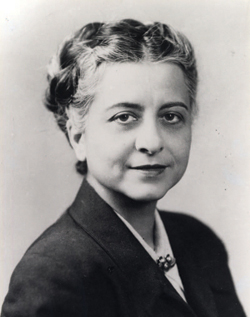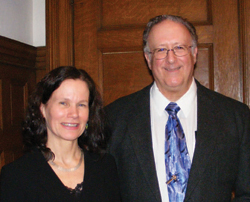Remembering a Trailblazer
TC Professor Josephine Rathbone's career in physical education and health spanned six decades in a male-dominated field
It’s just a picture of a group of people smiling back at the camera, but to Carol Ewing Garber, Associate Professor of Movement Sciences, it speaks volumes about its time. Taken in the early 1960s, it shows Josephine Rathbone—the lone woman founding member of the American College
“When you think about the role of women when she started and being the only woman founder of ACSM and then realize that now more than half of the attendees at the annual meeting are women, it illustrates how far ahead of her time she was,” Garber says.
Rathbone, a professor of health and physical education at TC from 1930 to 1958, is considered among the pioneering American scholars in the field of physical education and activity for those with disabilities. Rathbone’s life and times were the subject of a retrospective at TC on March 31 as part of Women’s History Month.
The event, “Josephine Rathbone, Ph.D.: A Role Model for Contemporary Women in Academia and the Professions,” was organized by Garber and featured the reflections of Tyler Griese, Assistant Director of Fitness at Norwalk Community College, who was one of Rathbone’s students at Springfield College, where she taught after retiring from TC.
Griese, who was Rathbone’s graduate assistant and has researched her career, recalled coming across a Time magazine article from 1939 that featured the then-Assistant Professor at TC and her work on relaxation. It began:
“Dr. Josephine L. Rathbone worries about people who worry. Dr. Rathbone, a stocky, cheerful little woman who rowed four years on the Wellesley
The description of Rathbone was the kind of patronizing attitude that she would endure in her career, but Griese said that when he met her late in her life, she was neither bitter nor phased by working in a field dominated by men. Instead, he found her to be strong, confident and kind.
“She had her cake and ate it, too,” Griese says. “She was definitely a strong person and a pioneer in so many areas, and she nonetheless exemplified very traditional feminine ways in many aspects.
“She was not a large person, but she could fill up a room. There was certainly an unquestioned air of authority—a quietly strong one about her. There was never any question about who was in charge in the classroom. She had a tremendous air of comfort with herself, with who she was and what she had done.”
During a career that spanned six decades, Rathbone became known for her work on adaptive physical education, or physical activity for those with disabilities. Her book, Corrective Physical Education, published in 1934, was one of the first on that topic in the United States
Rathbone joined the TC faculty in 1930 as an instructor while still a doctoral student in physiology at Columbia University
In addition to work in adaptive physical education, Rathbone wrote extensively about the medical applications of exercise for rehabilitation and the role of relaxation as part of overall well-being. At TC, she established a relaxation clinic, which treated patients for stress and other ailments by teaching them ways to relax.
She also wrote books that were widely read by lay reader, including How to Relax and Health in Your Daily Living, and was routinely quoted in the press on issues of health and wellness.
In 1954, Rathbone and her husband, the eminent Springfield College physiologist Peter Karpovich, helped found the Federation of Sports Medicine, which the following year changed its name to the American College of Sports Medicine, now a flagship organization for the field with some 20,000 members around the world. In 1974, the organization awarded Rathbone its highest honor.
After her death in 1989, ACSM created the Josephine L. Rathbone Memorial Breakfast at its annual meeting—an event that Garber routinely attends.
“It’s one way that her legacy is honored, and the breakfast focuses on the role of women in the college and women’s roles in sports and exercise-related professions,” Garber said. “She was a visionary and trailblazer and I and others owe her a great debt.”
Published Monday, Jun. 1, 2009

